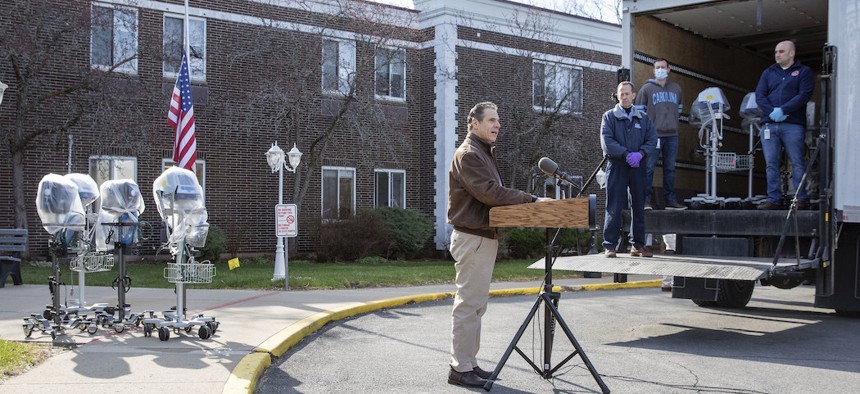In late January, amid mounting scrutiny of New York’s reporting on COVID-19 deaths in nursing homes, Gov. Andrew Cuomo responded with some exasperation to a question about his administration’s unique way of reporting deaths – counting only deaths that occured in these facilities, and not ones that occurred after residents were transferred to hospitals, in the total count of nursing home fatalities. “Whether a person died in a hospital or died in a nursing home, the people died,” Cuomo said at the time. “But who cares? 33%. 28%. Died in a hospital. Died in a nursing home,” he added. “They died.”
As it turns out, a lot of people care, including public health experts, who say the timely release of complete and granular data on COVID-19 deaths is not only crucial as a matter of public transparency, but also for crafting policies to respond to the evolving public health emergency.
The conflict over the Cuomo administration's handling of and reporting on COVID-19 deaths in nursing homes has blown up in recent weeks, as the state was compelled by a judge to release a more complete count of nursing home deaths – including both deaths in the facilities and in hospitals – which showed the total count was over 13,000, compared to the 8,700 deaths the state had reported a few weeks earlier. (The Cuomo administration didn’t understate the number of total deaths, it just failed to include deaths among nursing home residents – which now total 13,453 – that occurred outside of nursing homes.) The release of this more detailed and complete data was followed by a New York Post report saying that a top Cuomo aide attributed the delay of complete data to fear that it would be used against the administration in a probe by the Department of Justice. Allegations of a coverup, calls for resignations and a semi-apology from Cuomo swiftly followed.
The more detailed and complete a picture the data paints, the better health officials and policymakers are able to respond to a crisis, some public health experts said. In the case of nursing homes, reporting deaths that occured in facilities and in hospitals would have been incredibly useful, said Wafaa El-Sadr, a professor of epidemiology at Columbia University. “It gives you a much better sense of the magnitude of the impact when you combine those two pieces of data together,” she said. “Maybe having those numbers aggregated would have led to raising the flag earlier about the catastrophe that was happening in nursing homes – not just in New York City or New York state – but across the country.”
Data that is as detailed as possible is critical for public health officials and local governments, too. “When you are selectively releasing data – for example, around people who might be dying in the hospital, rather than in nursing homes – what you're doing is you're providing a misleading pattern for the public health community that is trying to understand where to allocate resources in an emergency,” said Harold Pollack, a professor at the University of Chicago’s School of Social Service Administration and co-director of the University of Chicago Health Lab. “It's both a matter of public trust, but also a matter of giving the tools to the people who are trying to come up with a battle plan in real time to deal with an epidemic.”
It’s not clear that the lack of data on nursing home deaths was linked to specific missteps in policymaking by the Cuomo administration or local health officials, and it’s hard to speculate what could have been done with more complete data. But in theory, El-Sadr said that more complete data released earlier on might have led to more targeted steps at facilities or in areas seeing a particularly bad spread, such as more stringent quarantine orders. A spokesperson for Cuomo did not respond to a question about how data might have affected policymaking or to the suggestion that more complete data could lead to a better pandemic response.
Rebecca Betensky, a professor and chair of the Department of Biostatistics at New York University’s School of Global Public Health, said that she didn’t see as much of an issue with not including nursing home deaths in hospitals in the count of nursing home deaths in facilities, as long as it was made clear that the count of in-facility deaths didn’t include those hospital deaths. “As long as the context of the data – where they’re coming from and what they mean – is provided alongside the data, then I don’t see a problem with that,” Betensky said. But she noted that if policymakers are asking for a full count of nursing home deaths, for example, in order to craft their response, then that data should be provided.
It’s not just in the conflict over nursing homes that lawmakers and public health experts are calling for a more granular and timely release of COVID-19 data. Both New York City and the state have faced pressure to release detailed demographic data on COVID-19 vaccinations, especially amid concerns that people of color, older New Yorkers and low-income communities will face extra obstacles to getting vaccinated. The city and state have slowly started to release data broken down by categories including race, ethnicity and location.
It’s this kind of detailed data that will allow local health departments or policymakers to target new outreach efforts or build new vaccine hubs in areas with low vaccination rates, for example. “It is by getting these kinds of disaggregated data that you can shine a light on where there's a problem,” El-Sadr said. “Not because you want to point fingers, but because you want to rectify situations that appear either when there's a gap or there's inequity.”
Correction: The latest count of nursing home deaths is 13,453.


